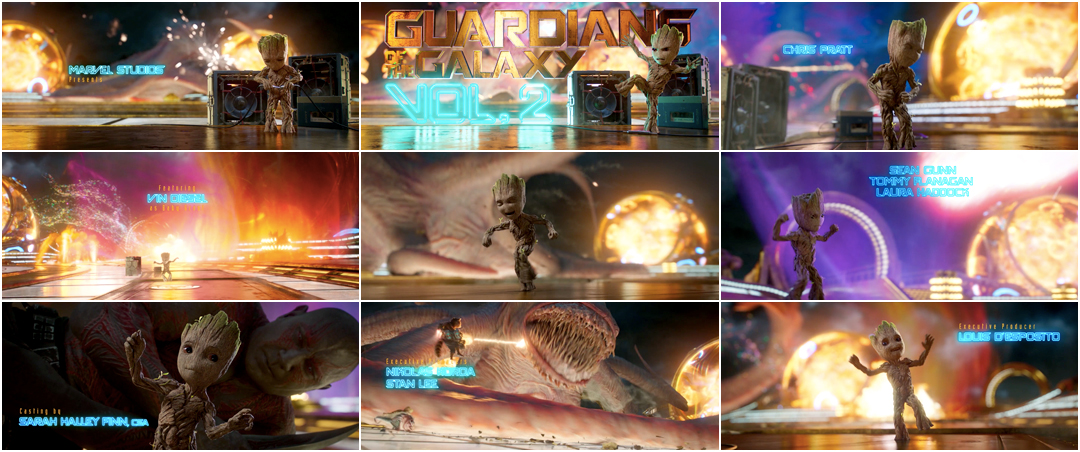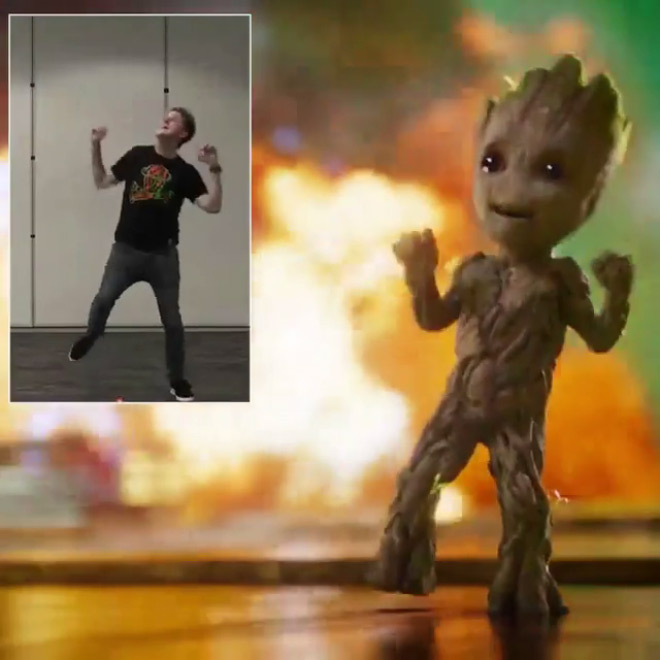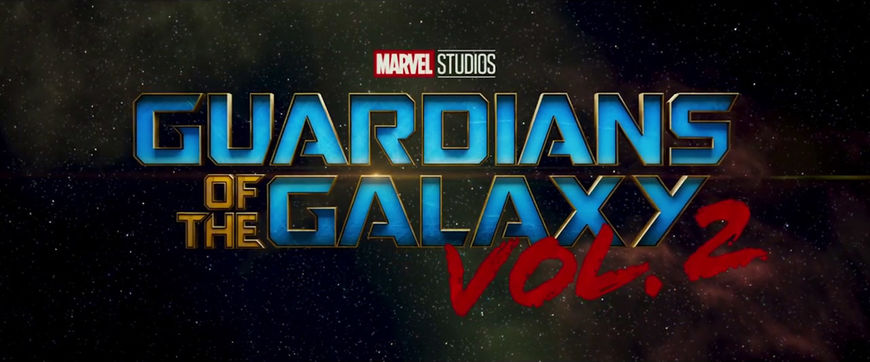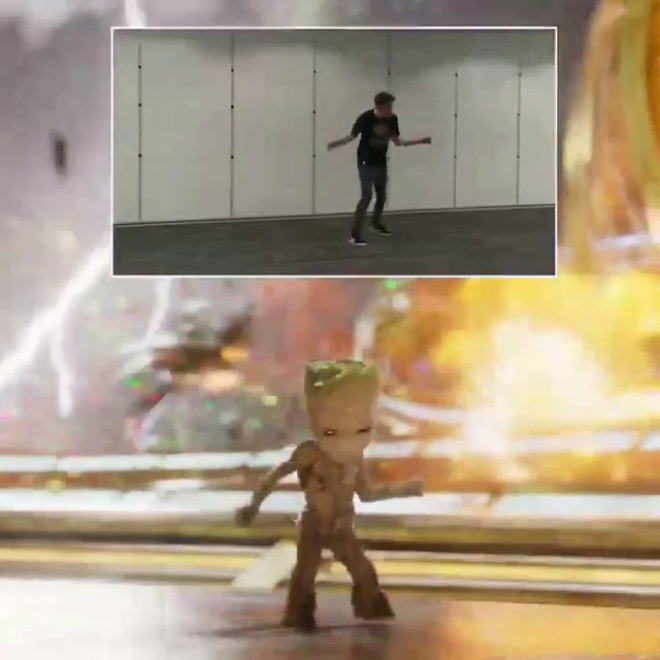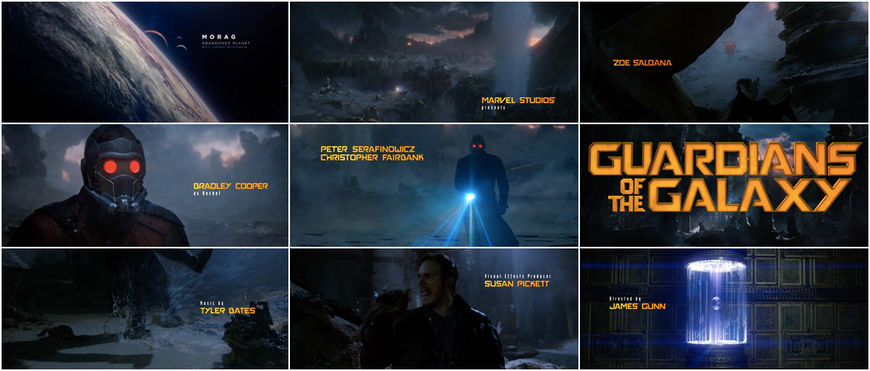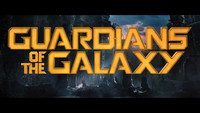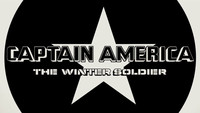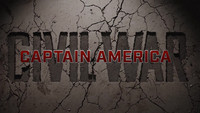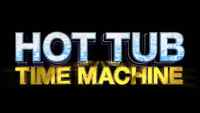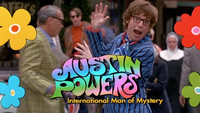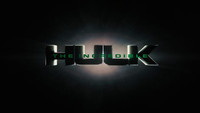The joy is in the details. And there is no shortage of detail in the bombastic, toe-tapping opening to Guardians of the Galaxy Vol. 2. The two-time galaxy savers – Star-Lord, Gamora, Drax, Rocket, and, of course, Baby Groot – are at it again, this time battling the Abilisk, a giant interdimensional beast.
Baby Groot, mischievous and distracted and utterly in his own world, dances to music from Star-Lord’s second mixtape while the Guardians throw down in the background, out of focus. The focus on Groot instead of the main action is the first comedic thrust of the film, a hilarious stroke of wit that dumps audiences in medias res but with the major action just beyond reach.
Although Baby Groot is voiced by actor Vin Diesel in the film, the tiny tree character’s dancing is actually based on director James Gunn’s own movements. Gunn’s love of music was directly translated to the screen by visual effects company Framestore, who used a video recorded by associate producer Simon Hatt on an iPhone in Gunn’s home office just after he’d written the opening scene. In the video, Gunn dances freeform, with moves “made up on the spot” but clearly in character as Groot. “I’m trying to move my body that [sic] works for a little tree more than what I’d be dancing like in a nightclub in L.A.,” said the director.
Director James Gunn dancing to provide reference footage for Groot's animators, via Instagram
The custom typography developed by Sarofsky for the first Guardians of the Galaxy film returns here, this time in rusty gold and glowing blue neon, providing familiarity and brand consistency. The title card freeze-frame puts Baby Groot in a Matrix-like pose, impervious to – and ignorant of – the mayhem around him. As the camera buzzes between laser blasts and flailing tentacles the film’s credits appear wherever there’s room. Meanwhile Groot continues his dance, adorable and oblivious to the events around him, losing himself to the music.
Like Rob Gordon says in 2000’s High Fidelity, “The making of a great compilation tape, like breaking up, is hard to do and takes ages longer than it might seem. You’ve got to kick it off with a killer to grab attention.” The killer song here is Electric Light Orchestra’s infectious “Mr. Blue Sky,” a soaring Beatlesque composition penned by songwriter Jeff Lynne in 1977. It’s been used in a handful of films including Eternal Sunshine of the Spotless Mind and The Invention of Lying, but perhaps the most interesting place it’s been played is in space. In 2011, the song was played as a wake-up call for astronauts on the final mission of Space Shuttle Atlantis. The opening of Guardians of the Galaxy Vol. 2 recalls that usage, giving the Marvel film a jump-start, juxtaposing the bright and irresistible “Mr. Blue Sky” with something truly out of this world.
A discussion with Executive Creative Director ERIN SAROFSKY of Sarofsky and Animation Supervisor ARSLAN ELVER of Framestore.
So Guardians of the Galaxy Vol. 2 is Sarofsky’s sixth Marvel project to date. How do these projects typically come to you at this point?
Erin: What’s really funny about Guardians of the Galaxy Vol. 2 is that they shot the whole opening sequence specifically to have the type in there, but it actually wasn't until towards the end of the process that we were brought in. I can’t remember exactly the schedule, but it was a few months to the finish line.
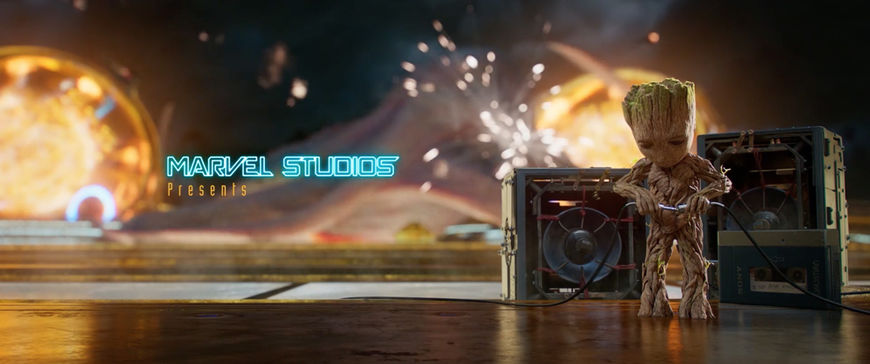
So what were your first conversations with director James Gunn about this? Where did this all start?
Erin: We went out to see the movie and then we had a conversation with him after the movie. That doesn't always happen – it depends on schedule and availability – but we got to have a conversation with him. He was very specific about what he wanted, but was also open to other things. He was intrigued to hear what we thought because we’d been through the whole process with him once already and there was at least a basis for dialogue. At first he was thinking that it might be a different typeface, but I was like “Ooh, but it’s branded!” [laughs] “It’s very important! But we’ll show you some options that aren’t that”... but I was obviously going to push very hard for it to be at least a version of the same typeface – something that at least nodded to what we did in the first one. It got there, but he did have to see it. He wasn’t tied to it though, which was kind of cool.
—Erin SarofskyHe’s the only director that we work with who does that. He literally wrote this sequence as a bed for main titles.

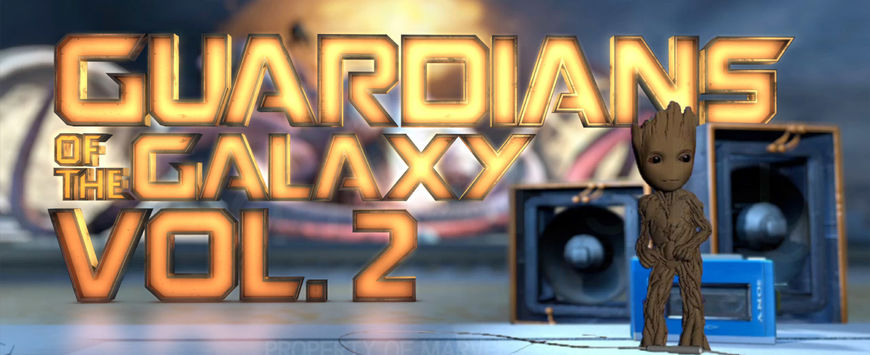
Guardians of the Galaxy Vol. 2 (2017) early title design concepts
Erin: Then we had a big round of visual exploration, like we always do. Here’s a bunch of ideas! What if we built off the typeface we created from last time? What if we rendered it a bunch of different ways? Here’s some flat options, some 3D options, some in the space, some not in the space. We went through that creative process with them. It was as big an endeavour as it would be with a full main-on-end, but it’s just a little more microscopic in terms of the actual letterforms and things like that. It’s nice to be able to focus on type in that kind of a way.
So it sounds like you didn’t have to pitch on this project as might usually be the case...
Erin: In this case we were the only people brought in, but typically in the Marvel space we do have to pitch every time. [James] really liked where we were at on the first one and our ability to do “simple”. He knew that it was going to have to be really simple. The wireframes we saw for the opening, they had the orbs in the background and the plates for the actors and things like that. The choreography was pretty much there, but we didn’t see any of the stuff in the background. He was the only one who knew how far it was going to go – and nobody else probably.
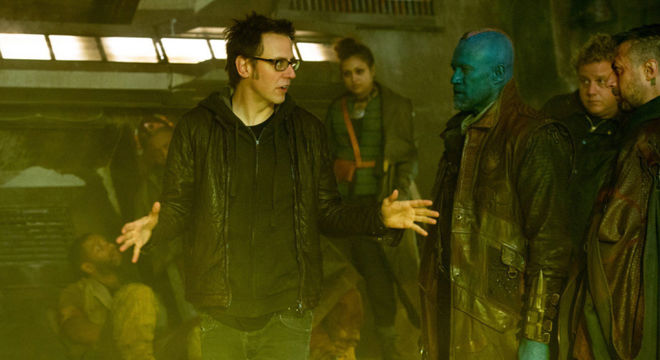
Guardians of the Galaxy Vol. 2 director James Gunn on set with actor Michael Rooker.
Arslan, could you tell us about Framestore’s primary role on Guardians of the Galaxy Vol. 2?
Arslan: We were tasked with creating the main assets of the show and distributing them to other vendors. We recreated Rocket with a better costume, hair simulation and facial expressions. We also created the Baby Groot asset, model, rig, and find his character through exploration of the performance, how human he is, how child-like or not.
Besides creating the main characters we were tasked with approximately 600 shots. These included the film's grand opening scene, Ayesha's lair, the space chase, and the Eclector scenes when Rocket, Baby Groot and Yondu are imprisoned in the ship.
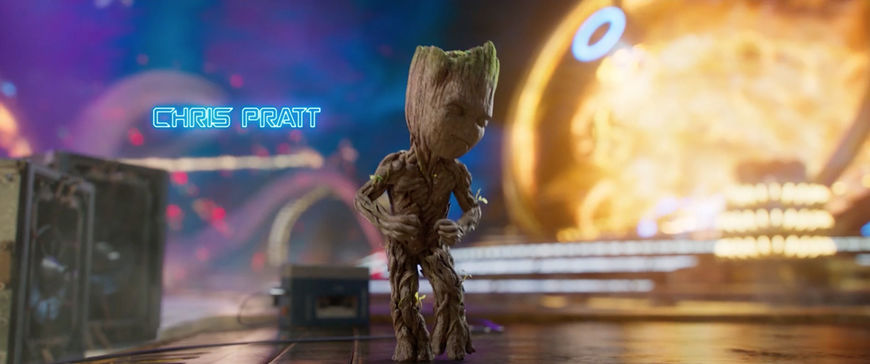

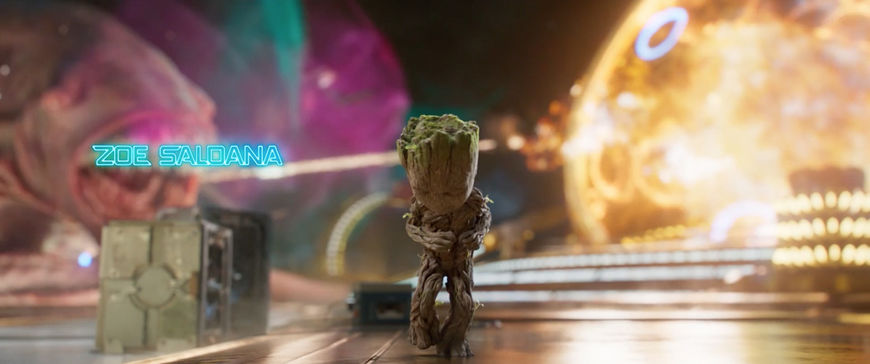
What were some of your initial conversations about the film’s opening sequence? Were James Gunn or the producers at Marvel involved in those discussions?
Arslan: By the time I joined the show there was already a very detailed previs done by The Third Floor. All the camera moves were established and roughly what was happening in the background. Groot's performance wasn't there, obviously. It was a stick figure moving in a cycle. The big thing for James was there is this massive fight going on in the background and Groot isn't even aware of it. He is in his own world. He dances with his eyes closed or he gets distracted by the Orloni – the creature Groot rides. He wanted to play with this idea a lot. It paid off massively.
Erin, what did that first version of the opening you saw look like?
Erin: It was a very heavily visual effects sequence. All the characters were shot against green screen doing their wire work, so really nothing was there. All that was there were the circular platforms that they were standing on, the orbs in the back, and the beast in very crude form – all of the main elements were in there. But they had the people cut out as they’re flying around and sometimes you still saw the wires. There were two shots that were pretty finished-looking because by that point the trailer was out. So those two little chunks were there, but even then they changed those shots – they were still working on them. Just because it’s in the trailer doesn’t mean it’s finished!
Guardians of the Galaxy Vol. 2 (2017) teaser trailer
Arslan: There are only small bits of real footage. When Quill falls on the ground and shoots next to Groot dancing, and when he says "Groot!" and then gets smashed by the tentacle of the Abilisk – that’s real. Gamora talking to Groot before flying off is real. And Drax rolling in and stopping behind Groot is real. Only a few elements, really. The majority is CG and digital doubles. For example, when Drax falls on the speakers we ended up using CG Drax because for purposes of interaction and animation it was just easier.
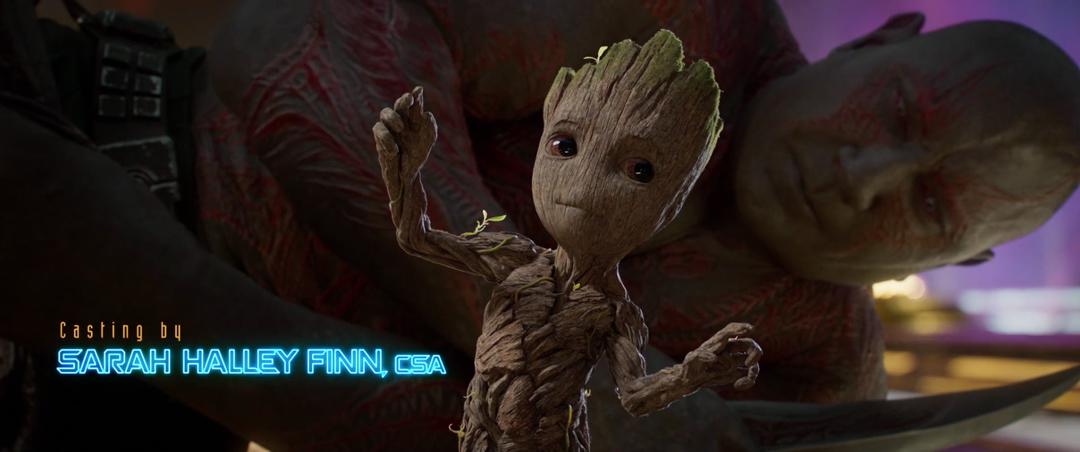
Erin, it seems like being able to focus just on the typography would be less work for your team, but you had to make it work in this larger context with so much happening in the background. Was that a challenge?
Erin: Completely! That was a huge obstacle. All the [visual effects] work that Framestore did was obviously incredible, but a lot of the work that we saw when we did our initial first pass wasn’t there. All of the layers of effects, the explosions, a lot of that just wasn’t in there. So every new pass we got from them had more and more and it was like, “Oh, well I guess the type can’t go there… or there.” [laughs] Or it was like, “Oh shit! We have to rethink our type completely because there’s now all of this colourful, effervescent plasma that’s spewing everywhere.” So it continued to be a moving target. They’re figuring out the process too, so if anyone is going to be the one reacting and changing, it’s us.
Were all the Baby Groot dance moves already figured out?
Erin: Oh yeah! It was blocked out. There was no Sean Gunn dancing or anything like that, but it is James Gunn dancing and then they modeled it around him. He does the dance and Baby Groot gets animated based on that.
Arslan, how did Framestore turn James’ dance moves into the animation for Baby Groot?
Arslan: James is an amazing director. He is really invested in his movie and his characters. He did this little dance at the end of Guardians of the Galaxy for Baby Groot in post. He generously did the same for this massive shot. He danced out the whole sequence. We had to change some parts of it to make it work with the camera speed or the specific moments, but he was the soul of it and a big inspiration.
—Arslan ElverWe had to change some parts of it to make it work with the camera speed or the specific moments, but he was the soul of it and a big inspiration.
Director James Gunn dancing to provide reference footage for Groot's animators, via Instagram
Arslan: We didn’t motion capture it though, because mocap creates a feeling of a human under the skin of Groot. He wouldn't be able to do such complex motions like a human would, so we carefully analyzed his performance and animated by hand a fully keyframe Baby Groot.
So aside from Groot, how does production on a big, complex VFX sequence like this typically start? Can you walk us through how it gets from a page in the script to something that begins to resemble the final product?
Arslan: There is a script of course, but a sequence like this really starts to flesh out with previs. James worked with the previs team based on the song he chose in great detail. After many iterations they get a version James is happy with. That previs then came to us. We looked at it and since it's one single shot it would have been impossible for one person to animate the whole thing or light it or comp it. So we split that one long shot into 11 pieces. We tried to pick the places that made sense for an easy transition between the chunks. When we received the previs, the titles were already there. Although they were 3D titles that lived in the actual space rather than stay on the screen like it is now.
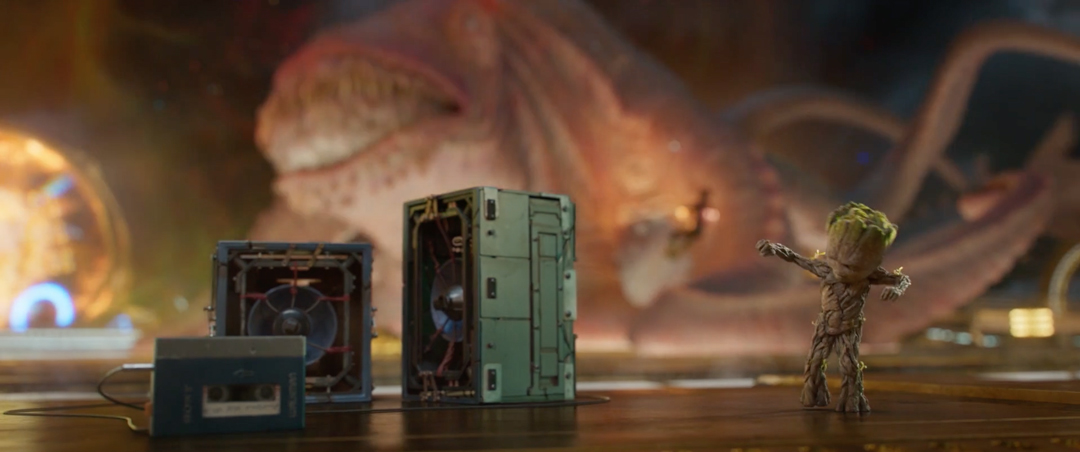
Arslan: The next step is to start to block out the performance of Groot based on the cameras choreography. Since the geographic position of Baby Groot is very important, the challenge was not only create a great performance but also make sure he ends up in the right places based on the previs and camera moves. Then we finesse the performance and finesse the hookups between the 11 shots, not only for Groot but also for the background action. It was a massive challenge to animate so many things in one single continuous shot.
It was quite a complex thing, really. Not only for animation but for cloth simulation, for FX, and for compositing. Every department had to deal with this, which takes time so it puts extra pressure on the schedule. As usual comp also helped a lot to cover some issues and make it look seamless and awesome.
Erin, what did the nuts and bolts of production look like on your side? What were the first steps?
Erin: Design. Always design. They’ll send us the opening, wherever it is at the time, and we start laying type on top of it, doing some motion tests, and just kind of getting a vibe for all the different directions they could take it. For Vol. 2 we really focused on three areas: one was doing three-dimensional type that was integrated throughout the whole title sequence in the space, kind of like how Guardians of the Galaxy was. Then we explored doing some 2D type options on top and then we looked at some flat type brought on by dimensional things. So like creating a little hovering character that projected a hologram up on the screen, something completely out of the box. They were like, “Holy shit, that’s cool!”
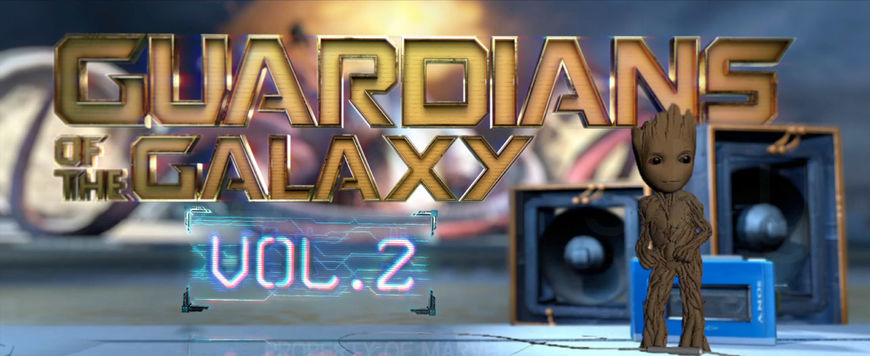
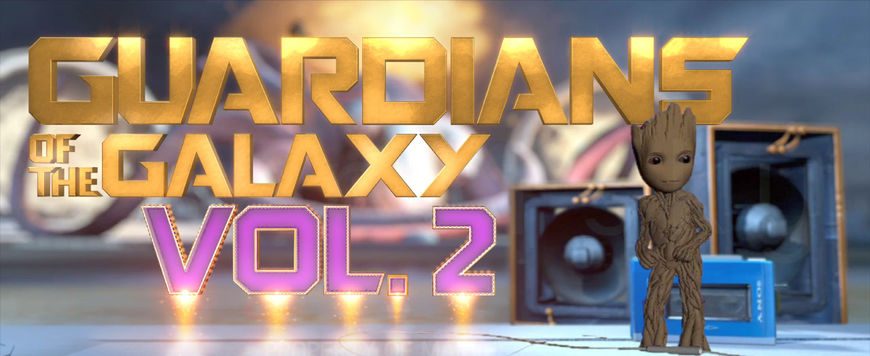
Guardians of the Galaxy Vol. 2 (2017) early title design concepts
Erin: I thought that had a real chance of living. It was an interesting, innovative solution. It was completely left-field. We talked about the 3D type in the space, we talked about simple 2D type, and then we came up with three or four other ideas for how to handle it. He looked at that, got really interested in that, and then it started to dawn on him that that would mean we’d have another character in the sequence. This little hovering thing, big or small or floating around, whatever form it takes on, it’s another character. What’s cool about it is that it could fly away from the action, you know? It could move to the side and accommodate any animation that Framestore was doing. It was a clever idea, but then he started worrying about having to deal with another character in a complicated scene. So the whole process became one of simplification. How little can we do to mess with this fun narrative that’s already going on?
So you ended up settling on the 2D solution for most of the sequence with the exception of the title card reveal, which actually interacts with the scene in a cool way. Could you tell me a bit about that element of the sequence?
Erin: That was a cool process because that had to physically be in the space. We designed the typeface, we extrapolated it out, we modeled it, we did render tests and texture tests, and book frames, and then ultimately we took all of our models and assets and handed them off to Framestore to actually put into the scene. So it’s rendered into the scene!
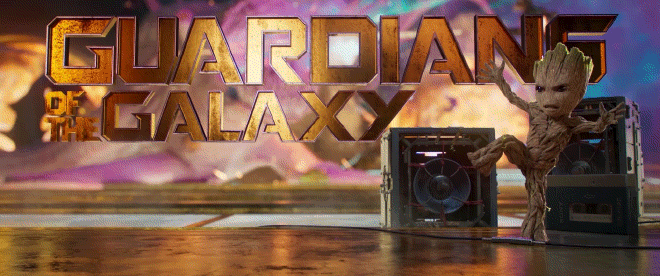
The final title card as it appears in Guardians of the Galaxy Vol. 2 (2017)
Arslan: The freeze-frame was James’ idea but it wasn’t really fleshed out in previs. He was keen to see different versions of the shot and he liked the freeze-frame version so we ended up doing it. We got the model from Sarofsky and applied our shaders. The gold material of the platform was added and placed into the animation scene. One nice touch was the “Vol. 2” part of the title card. It plays like a neon tube and the lighting of that interacts with the environment and Baby Groot. It was a nice touch.
Erin: We worked with all of their working files, which they’d sent to us, and we built in their environments so everything was exactly to scale. We’d send them tests and they’d review them and be like, “Actually, it’d be cool if your files were a little bit more like this!” We would accommodate. So when they got our work it was basically just plopped right into their world.

Is that an unusual process for you guys to hand your work off like that?
Erin: Yes! [laughs] On the main title side for sure because usually it’s all in our world. Sometimes we deliver titles to Technicolor to go on top of something else, but that’s a bit different. We had to totally work inside their pipeline, which was quite extensive. We had it looking exactly the way we wanted to, so it wasn’t like we handed off a 3D model and were like, “Texture it however you want it!” We had proper 3D rotations of it where the lighting moved around it, so they could see what our full intention was.
We had a lot of communication with Framestore. They built these scenarios, everything was in place and approved, and their pipeline was more challenging than ours. We wanted to be as accommodating as possible to be able to address James’ notes but also make sure that we weren’t messing with anything they were doing. We were trying to treat them how we would want to be treated in that situation.
The Guardians series is unique amongst Marvel movies in that they feature elaborate opening credit sequences – most other films in the franchise forego an opening in favour of a strong main-on-end title sequence. Could you talk about James Gunn’s approach to these sequences in your conversations with him and how it might differ from the other directors you’ve worked with?
Erin: He writes it into the script. I think he’s the only director that we work with who does that. He literally wrote this sequence as a bed for main titles. He also puts the music in the script. There’s a musicality to all of his work. That’s a big part of the tone of the Guardians movies and I think part of why people love them so much.
Guardians of the Galaxy (2014) main titles, designed by Sarofsky
Erin: It’s completely different when you’re walking into something that is already planned versus a situation where you’re just told, “I don’t know! Show us some cool stuff and we’ll pick.” Totally different. He’s not a typographer or a traditional designer, but he certainly has a very specific point of view when it comes to the design of this. He definitely knows what he wants – and he knows what he doesn’t want. We could show him the coolest-looking thing and be like, “He’s gotta bite on this!” He wants the simple thing. He’s the one with the vision for what it’s going to look like all the way through.
Is there a specific element or moment in the main title that you’re most happy with?
Erin: I’m just happy that they fit into the tone of the movie. They’re really fun, but I’m really proud that they didn’t get in the way of anything to be honest. There were a lot of solutions that could have been too much, but we erred on the side of simplicity and that served the larger purpose there.
Arslan, do you have a favourite moment or element that you’re most happy with?
Arslan: That’s like asking, “Who is your favourite child?!” To be perfectly honest, it's the whole of it. There is so much fun stuff and contrast in that long shot. It took months to get it done and it was worth every bit of sweat and blood.
OK! So let’s talk about the end title and the crawl.
Erin: Yeah! That’s our first one ever.
Guardians of the Galaxy Vol. 2 (2017) end title sequence including crawl and stingers
The “Guardians of the Galaxy Will Return” is obviously nice nod to James Bond, but tell us about some of your inspirations for the lasers carving out the type.
Erin: It was stuff from the movies! We obviously took the typeface from the beginning and we wanted it as this outline, but the question then became “How can we bring this on in a cool way?” I want to say “PEW PEW!” but that’s Star Wars, but this was pulled from the film, the ships and their lasers. So we kind of matched that. We thought they were going to want to do something a lot simpler, so we called this treatment “Crazy Lasers”. [laughs] “Crazy Lasers” is the treatment and that’s what it was called the entire time.
We didn’t know what the best approach was. The end of the movie with Rocket crying was just so emotional, so I just did not think they’d go with “Crazy Lasers” in a million years. I thought they were going to want to ease you into it. But they blare right into that fun music to snap you out of it. They obviously had the vision to understand that, but we wanted to provide options. In editorial they put things in and see what feels right, and “Crazy Lasers” for the win!
Now with so many stingers – the after-credits scenes – does that throw a wrench into what you guys have to produce? Do you have to produce more content for the crawl in that case?
Erin: It is a major wrench! It is the epic wrench. When we were presenting our solutions for the main title, we were in there with Victoria Alonso and James and Kevin Feige and Louis D'Esposito – all these really impressive people – and I say we’re done. I’m going to get up and say “Okay, cool so we have our direction!” “No, no, we want to talk to you about something else. We want you to think about doing the end crawl.” I was just like “No. No, no, no, no, no! We’re not doing an end crawl.” Everybody was just kind of looking at me like I’m totally bananas. But then Victoria suggested that we have Exceptional Minds continue to set the type in whatever style you dictate. They’re this great company out in Los Angeles – they’re more of a university actually – that helps kids on the autism spectrum find work in post-production. Victoria is very committed to making sure they have work. It’s really great!
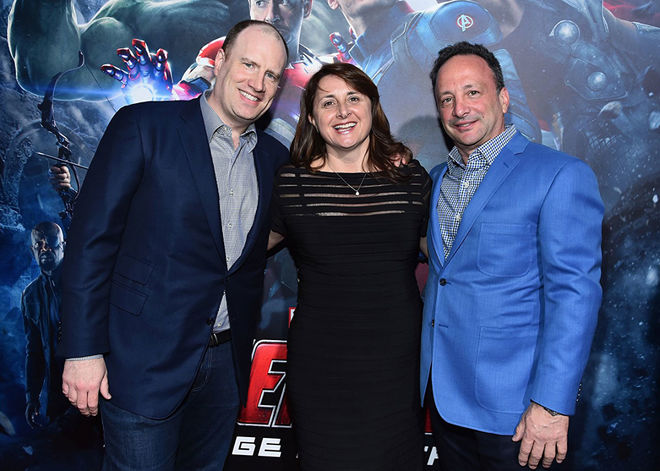
Marvel Studios executives Kevin Feige, Victoria Alonso, and Louis D'Esposito, 2015
Erin: The idea was to have Exceptional Minds set the type and we’d do the design. The problem as they explained it was that they had all these tags and were adding more, and they needed a design solution that was going to keep people in their seats. That was the coolest thing I’d ever heard. So we started talking about it a little more, they told me what the tags were, and sent a couple over that they already had, and then we started designing and coming up with solutions for what this end crawl could be. It’s thousands of people’s names! Thousands of names.
So you brought in Exceptional Minds to do that the typesetting and credit checking parts of the crawl?
Erin: Yeah, so we went through the process of choosing a typeface, choosing the size and speed, and the technical process of strobing and all that stuff. We came up with the formula for how it should look and then they set all the type and provided renders to us. We’d then put that into our design. The process with Exceptional Minds was that they gave us white type on black, just scrolling, and then we put it into the bigger design and delivered it to Marvel.
How would you describe that bigger design, the concept for the end titles? It sort of looks like album covers from the 1970s.
Erin: Old album art! Totally inspired by that. Marvel’s legal team is the greatest, so we couldn’t get away with doing anything referential or specific, but there is a vibe to it where it feels like ‘70s album art 100 per cent. We took albums and scanned the old textures. We raided all of our family’s closets and got all these albums that were all scratched up. We scanned that and put that in there because we thought it was an important part of the textural nature of it.
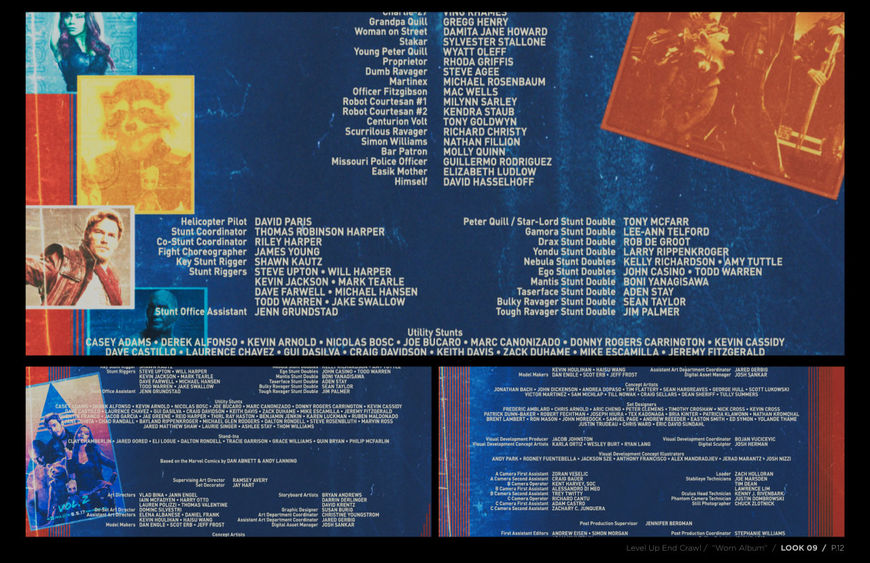
—Erin SarofskyThere is a vibe to it where it feels like ‘70s album art 100 per cent.
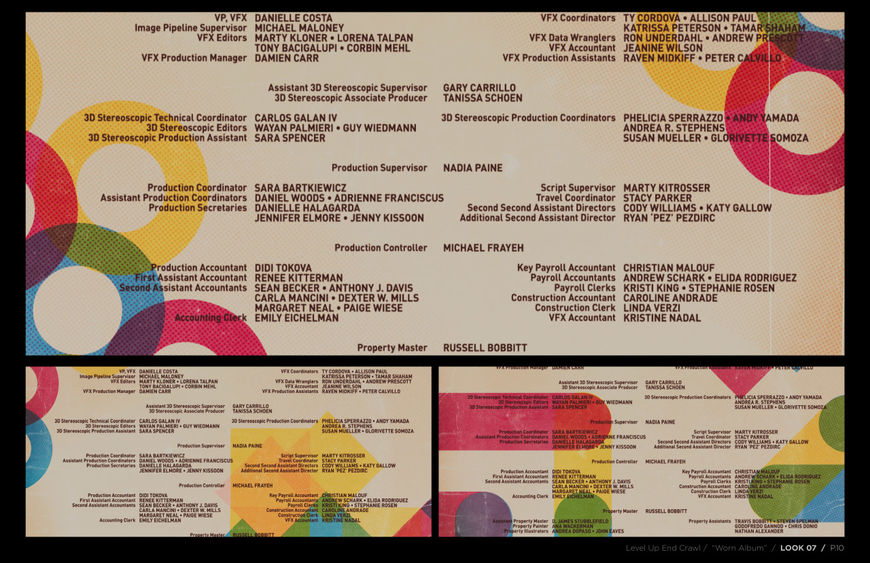
Guardians of the Galaxy Vol. 2 (2017) end crawl concepts
And you’ve also packed in all these little details and blink-and-you’ll-miss-it gags. Were those dancing characters shot or created specifically for the end crawl?
Erin: They just shoot a whole bunch of random shit. They do it when they’re doing promo shoots, they do it on set, they do it all the time. They shot some of those tags pretty late in the game, so they’d grab things. We didn’t get any of the David Hasselhoff stuff until the very end. David Hasselhoff actually sings that last song, so they were doing a voice record with him and decided to shoot him for the end. The whole point was for it to feel janky and gif-like, so we just started popping stuff in and making it work.
Yeah, it’s got that whole Boomerang effect to a lot of the movement!
Erin: Totally! And we also had the flashing type that started out as “I am Groot” and then changed to people’s names. My big thing that I think that Kevin liked for sure and James got obsessed with was like “What else can we put in here? What are these Easter eggs that we can use to keep people in their seats?” It became their obsession all the way to the very end.
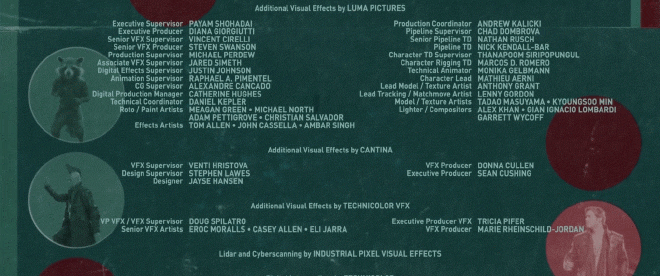
Guardians of the Galaxy Vol. 2 (2017) end crawl excerpt
Do you have a favourite Easter egg or moment from the end crawl?
Erin: I love that row in the blue world where they’re all dancing. I think that’s so fun. You’ve got Mantis in there, Rocket’s in there – Rocket is dancing so somebody had to animate that for us! “We’ll call so and so and have them animate Rocket for you.” Just to make a little gif. Rocket was created for us. We didn’t have him dancing until the very end. They also must have been shooting Thor: Ragnarok at the same time because they were able to get footage of Jeff Goldblum dancing. He’s in one of the circles!
And Howard the Duck!
Erin: Yes! Of course.
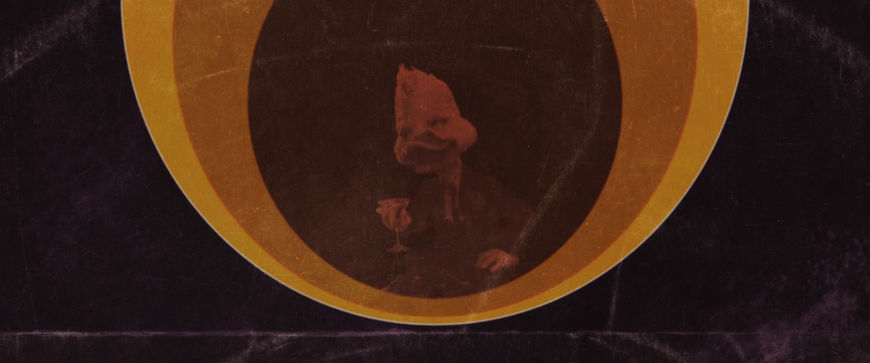
Howard the Duck's brief appearance in the Guardians of the Galaxy Vol. 2 end crawl
Arslan, did Framestore do any work on the characters in the end crawl or stingers?
Arslan: Yes. We were tasked with the adolescent Groot shots. James’ brother Sean played him on set and we used his performance for inspiration. Groot is playing some space video game and is being dismissive, like everyone is at that age. It was quite a fun thing to animate!
Erin, would you do an end crawl again?
Erin: They’re so long! Honestly, we knew it was going to be more work than we thought it was going to be because of their pipeline. When they do something they are all in! It was no joke, until the very end we were consistently working on it. We knew it would be cool, but we also knew it was going to be a giant challenge. And it’s stuff you wouldn’t necessarily see on screen. For example, if three names are added to it, it’s going to change the timing of the whole section in between the tags.
And is there a specific element or moment in the end crawl that you’re most happy with?
Erin: With the end crawl I’m just glad we gave people some entertainment while they were waiting for their cool tags. You go from a main title, which is essentially a legal document but can be very artful, to an end crawl, which is like reading a contract. My god! Unless your name or your kid’s name is in it, there’s a pretty good chance you’re not reading it! So to give people a reason to look through it, to laugh and be engaged with it was really cool. I’m really proud of that.
So are you ready to tackle another end crawl after this project?
Erin: I very well might say thank you but no, but I would at least hear them out. I wouldn’t get up and try to leave! [laughs]

